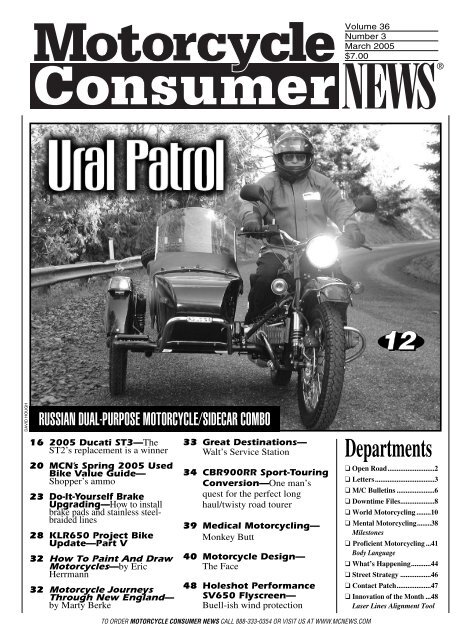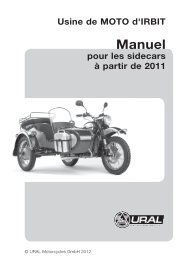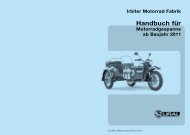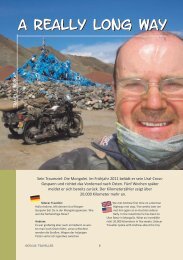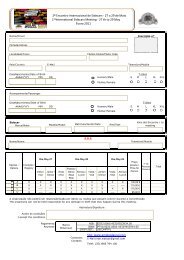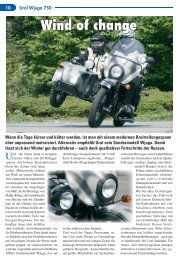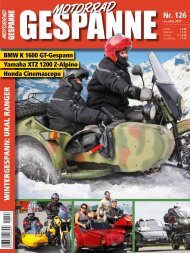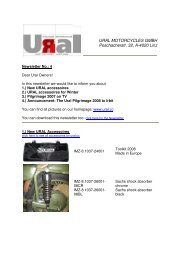Departments 1122 - Ural Motorcycles Europe
Departments 1122 - Ural Motorcycles Europe
Departments 1122 - Ural Motorcycles Europe
You also want an ePaper? Increase the reach of your titles
YUMPU automatically turns print PDFs into web optimized ePapers that Google loves.
DAVID HOUGH<br />
RUSSIAN DUAL-PURPOSE MOTORCYCLE/SIDECAR COMBO<br />
16 2005 Ducati ST3—The<br />
ST2’s replacement is a winner<br />
20 MCN’s Spring 2005 Used<br />
Bike Value Guide—<br />
Shopper’s ammo<br />
23 Do-It-Yourself Brake<br />
Upgrading—How to install<br />
brake pads and stainless steelbraided<br />
lines<br />
28 KLR650 Project Bike<br />
Update—Part V<br />
32 How To Paint And Draw<br />
<strong>Motorcycles</strong>—by Eric<br />
Herrmann<br />
32 Motorcycle Journeys<br />
Through New England—<br />
by Marty Berke<br />
33 Great Destinations—<br />
Walt’s Service Station<br />
34 CBR900RR Sport-Touring<br />
Conversion—One man’s<br />
quest for the perfect long<br />
haul/twisty road tourer<br />
39 Medical Motorcycling—<br />
Monkey Butt<br />
40 Motorcycle Design—<br />
The Face<br />
48 Holeshot Performance<br />
SV650 Flyscreen—<br />
Buell-ish wind protection<br />
Volume 36<br />
Number 3<br />
March 2005<br />
$7.00<br />
TO ORDER MOTORCYCLE CONSUMER NEWS CALL 888-333-0354 OR VISIT US AT WWW.MCNEWS.COM<br />
122<br />
<strong>Departments</strong><br />
❑ Open Road..........................2<br />
❑ Letters.................................3<br />
❑ M/C Bulletins .....................6<br />
❑ Downtime Files...................8<br />
❑ World Motorcycling ........10<br />
❑ Mental Motorcycling........38<br />
Milestones<br />
❑ Proficient Motorcycling ...41<br />
Body Language<br />
❑ What’s Happening...........44<br />
❑ Street Strategy .................46<br />
❑ Contact Patch...................47<br />
❑ Innovation of the Month ...48<br />
Laser Lines Alignment Tool
Model Evaluation<br />
IMZ URAL PATROL<br />
Motorcycle/sidecar<br />
Combination<br />
by David L. Hough<br />
FOR MOST RIDERS, the term “motorcycle”<br />
means a two-wheeler. But<br />
while only a small minority of motorcyclists<br />
have any experience with<br />
them, motorcycles equipped with sidecars<br />
are still “motorcycles” as defined by law in<br />
just about every state. So, we decided it was<br />
time to retest the Russian-built sidecar rig,<br />
the <strong>Ural</strong> “Patrol.”<br />
If you’re wondering why anyone would<br />
be interested in a Russian-made motorcycle,<br />
it’s because the <strong>Ural</strong> is the only streetlegal<br />
sidecar motorcycle available for sale<br />
in this country. Yes, we know there are various<br />
combinations being put together by<br />
clever individuals, and we know that Harley-<br />
Davidson sells both motorcycles and sidecars<br />
separately. But the <strong>Ural</strong> is the only one<br />
you can buy as a complete 3-wheeled motorcycle/sidecar<br />
combination, approved by the<br />
DOT and EPA.<br />
We’ve followed the <strong>Ural</strong> saga with considerable<br />
interest. Frankly, the <strong>Ural</strong>s of yesteryear<br />
verged on being serious rigs, but<br />
were always plagued by too many niggling<br />
problems. We’d heard the 2005 <strong>Ural</strong>s had<br />
been improved considerably, and we were<br />
very interested to see whether or not they<br />
had finally become durable go-anywhere<br />
machines.<br />
At first glance, the quality control of the<br />
2005 version is much improved over what<br />
we had observed just five years ago. The<br />
new engine and transmission castings are<br />
nicely finished, the chrome plating is excellent,<br />
the wheel spokes are straight and true,<br />
12 MARCH 2005 ● MOTORCYCLE CONSUMER NEWS<br />
and the paint quality is quite good. And<br />
there have been some impressive upgrades:<br />
The front wheel now carries an impressive<br />
Brembo four-piston caliper clamping on a<br />
massive 300mm disc, and the handlebar<br />
switch pods are neat and functional. Looking<br />
a little closer, excellent Keihin carburetors<br />
are fitted, a serious electric starter is<br />
nicely integrated into the rear of the engine<br />
case, and an automotive-style Denso 35-<br />
Amp external alternator supplies the juice.<br />
<strong>Ural</strong> has several other sidecar variations,<br />
including the “Gear Up,” basically a Patrol<br />
in miltary garb, with spare fuel container,<br />
spotlight, carrying rack, and a camouflage<br />
paint job, the “Tourist,” a Patrol without<br />
two-wheel drive, the “Troyka,” a deluxe<br />
version of the Tourist, and the “Retro,” a<br />
pinstriped Tourist. There are also two solo<br />
machines.<br />
Let’s Go For A Ride<br />
Okay, the improvements look good, but<br />
how does it all work? Starting is quick and<br />
painless; the fuel tank now has a vacuumoperated<br />
valve, so you don’t need to turn it<br />
on or off; the carbs have independent<br />
enricheners, so if it’s cold you need to reach<br />
down on each side and pull the knobs and<br />
the starter cranks the engine whether it’s in<br />
neutral or in gear. Simply turn on the main<br />
switch, flip the handlebar kill switch to<br />
“run,” squeeze the clutch, and thumb the<br />
starter. The engine starts easily, although it<br />
does take a few moments to warm up before<br />
the enricheners can be closed.<br />
Ease out the clutch and the 745cc engine<br />
pulls cleanly with very adequate torque. The<br />
action of the two-plate dry clutch is light<br />
and predictable and the engine is surprisingly<br />
smooth—quiet, and well-balanced<br />
enough that there is practically no mirror<br />
vibration or tingling through the grips or<br />
pegs. In fact, it feels very similar to a 1970vintage<br />
BMW “airhead” motor.<br />
However, when it’s time to shift, the honeymoon<br />
is over. The four-speed transmission<br />
requires considerable toe effort, and<br />
shifts with a solid crunch regardless of technique.<br />
You spin up the engine, then wince<br />
as you squeeze the clutch and crash into the<br />
next gear. We tried all the usual techniques<br />
to smooth out shifting, but nothing seemed<br />
to work—you just have to live with it.<br />
Also, the gearbox ratios are a bit on the<br />
tall side, especially 4th gear. The 750 engine<br />
has lots of torque for a 750cc opposed twin<br />
(38 lb./ft. @ 4000 rpm according to IMZ),<br />
but needs to be revved up to get enough<br />
power to maintain highway speed, and we<br />
found 4th gear just too tall for most situations.<br />
At a comfortable 55 to 60 mph, fourth<br />
would barely hold speed on the level. Typically,<br />
we just left it in third, which seemed<br />
to be fine for anything from 30 mph to 60<br />
mph. To be fair, this machine was almost<br />
new, and it should run better after a few<br />
thousand miles of break-in.<br />
Handling<br />
Steering effort is an important consideration<br />
with rigid sidecar rigs because they<br />
don’t lean into turns. Steering trail (“caster”)<br />
is much shorter on the <strong>Ural</strong>’s leading link<br />
fork than for a typical two-wheeler. But<br />
steering effort still required more muscle<br />
than we’d prefer. For a novice sidecar pilot,<br />
relatively high steering effort encourages<br />
slower speed in corners—which is probably<br />
a safety advantage. But we think experienced<br />
hackers would prefer even shorter<br />
trail for easier steering.<br />
The Patrol (and “Gear Up”) models both<br />
ride on 19" wheels for better offroad clearance,<br />
but that also makes them tall, and<br />
therefore less roll-resistant in corners. Normally,<br />
we would hang off in aggressive<br />
turns, but the Patrol comes with dual bucketstyle<br />
saddles. A bench-style saddle is an<br />
option for those who like to corner more<br />
aggressively.<br />
Of course, on-road manners must suffer<br />
somewhat to provide good off-road performance.<br />
On slick or unpaved surfaces,<br />
speeds are slower, and here’s where the<br />
Patrol really shines. You can putter down a<br />
forest road, splash through mudholes, or<br />
climb steep gravel sections without a lot of<br />
fuss. And, if you’re losing too much traction<br />
on the rear wheel, just reach down and<br />
engage the sidecar drive. Both wheels will
now churn away at the same speed until you<br />
extricate yourself, then it’s back to onewheel<br />
drive again. We think it’s a much better<br />
system than having a differential that<br />
allows either wheel to slip. And there’s no<br />
need to have two-wheel drive for normal<br />
pavement.<br />
Heading downhill into a dead-end is no<br />
problem, either. If you need to back up, just<br />
shift to neutral and pop the reverse lever<br />
down by your right heel, ease out the clutch,<br />
and the rig backs up with as much power as<br />
you need, for as long as you want. Reverse<br />
is a very low 4.36 ratio, compared to 3.6 for<br />
first gear. You can back up in two-wheel<br />
drive, too.<br />
The Sidecar<br />
The sidecar itself is heavy-gauge steel,<br />
with a classic design that’s very practical.<br />
We know from personal experience that<br />
you can carry a heavy passenger or a huge<br />
load of groceries or camping gear inside.<br />
Plus, there’s a cutaway at the cockpit side<br />
for easier passenger ingree/egress, and a<br />
huge (3-cu. ft.) trunk at the back, accessed<br />
by a hinged lid.<br />
The heavy tubular-steel sidecar chassis<br />
is supported on a single-sided trailing swing<br />
arm and monoshock, and the rear of the<br />
sidecar body is supported on huge rubber<br />
accordion “springs.” Suspension is very<br />
adequate for additional loads, and extra<br />
weight doesn’t seem to bog it down. In fact,<br />
with a load in the sidecar, right turns are<br />
much more controllable since there is less<br />
concern about the car flying.<br />
The Patrol has a pillion saddle over the<br />
rear fender, to enable carrying a passenger<br />
behind the driver as well as in the sidecar.<br />
However, novice sidecar drivers should be<br />
warned to avoid carrying an adult passenger<br />
on the rear of the bike unless there is an<br />
equally heavy passenger in the sidecar. My<br />
vote would be to remove the pillion perch<br />
until later in the learning curve.<br />
Brakes<br />
Braking is much improved with the<br />
Brembo caliper up front. More importantly<br />
for sidecar use, the caliper is now pivoted<br />
off the front axle, with a thrust link to the<br />
right down tube, to provide a neutral attitude<br />
when braking. Even during an aggressive<br />
stop, the front end doesn’t squat as with the<br />
typical telescopic fork. Nor does it rise, as<br />
when the brake is mounted on the leading<br />
link. This results in better traction control<br />
during braking, since there is no hop when<br />
the tire momentarily loses traction.<br />
The drum brakes on rear and sidecar<br />
wheels are adequate for their jobs, since you<br />
don’t need as much braking power on those<br />
wheels. Both rear and sidecar brakes are<br />
actuated by rods, with the sidecar brake connected<br />
mechanically through a lateral shaft<br />
to the rear brake pedal. Since both rear and<br />
sidecar brakes are independently adjustable,<br />
they can be balanced for smooth straightline<br />
stops. And we know those Russian<br />
brake shoes have thick linings that last “forever.”<br />
We’d rate the brakes excellent, except<br />
for a slight surge during hard braking on<br />
the front, perhaps the result of the disc<br />
being fixed rigidly on the front hub. But,<br />
considering the gritty environment of offpavement<br />
excursions, the fixed disc is an<br />
advantage, since it has no small parts to<br />
wear out prematurely. With the <strong>Ural</strong>, longterm<br />
durability is more important than highzoot<br />
brakes.<br />
Wheels<br />
All three wheels are chromed-steel rims<br />
attached to aluminum hubs with very stout<br />
(4.5mm) spokes. <strong>Ural</strong> wheels have always<br />
been strong, but their latest are very impressive,<br />
with clean hub castings, smooth, welldimpled<br />
rims, and nicely plated straight-pull<br />
spokes with heavy nipples. <strong>Ural</strong> wheels are<br />
also unusual in having threaded collars to<br />
allow adjusting bearing clearances without<br />
shimming.<br />
The rear wheel and sidecar wheel are<br />
interchangeable with the spare wheel carried<br />
on the sidecar trunk lid. When’s the<br />
last time you had a spare tire on your motorcycle?<br />
The Fun Quotient<br />
We used the <strong>Ural</strong> Patrol to run errands<br />
for a couple of weeks, and it drew a lot of<br />
attention. We’d get thumbs up while riding,<br />
and conversation every time we stopped.<br />
Sidecar passengers commented on how<br />
quiet the engine was, too. All in all, having<br />
a midsize sidecar outfit to run around on<br />
provides a lot of smiles.<br />
What we really like about a rugged dualsport<br />
sidecar outfit is being able to slip and<br />
slide down grotty unpaved roads without<br />
fear of falling, or concern about scratching<br />
any shiny paint. And, on those days when<br />
there was frost on the ground, we could still<br />
take a spin when properly bundled up—<br />
you’ve gotta love it.<br />
URAL HISTORY<br />
<strong>Ural</strong> motorcycles have been around since<br />
1939, when the USSR Defense Ministry<br />
decided to “reverse engineer” the BMW R71,<br />
and called it the “M-72.” By the end of WWII,<br />
nearly 10,000 <strong>Ural</strong> motorcycles had been<br />
delivered to the military, most with rugged<br />
steel sidecars.<br />
After the war, Russians used sidecar <strong>Ural</strong>s<br />
for basic transportation because they were<br />
cheap, tough, simple, and capable of managing<br />
rough roads through mud or snow.<br />
Since WWII, approximately 3 million have<br />
been produced by the factory in Irbit, a small<br />
trading town on the fringes of the Siberian<br />
steppes in the <strong>Ural</strong> Mountains.<br />
With the Soviet Union’s collapse in 1992,<br />
<strong>Ural</strong> began selling to other parts of the world,<br />
notably North America. For a number of years,<br />
<strong>Ural</strong>s were imported and distributed in North<br />
America by <strong>Ural</strong> America (a subsidiary of Classic<br />
<strong>Motorcycles</strong> and Sidecars), in Preston,<br />
WA. The American importers understood<br />
quite well that those early <strong>Ural</strong>s were very<br />
crude, and improvements were suggested as<br />
quickly as the Russian managers in Irbit could<br />
be convinced of the need. Specifically, the<br />
machines drastically needed more power,<br />
greater reliability, and features such as electric<br />
start and efficient carburetors.<br />
Meanwhile, in 1998, back in Russia, the<br />
<strong>Ural</strong> factory was privatized about the same<br />
time that Russian citizens were deciding in<br />
favor of automobiles for basic transportation.<br />
Sales of domestic <strong>Ural</strong>s slumped, and<br />
production dwindled from 132,000 sidecar<br />
motorcycles in 1994, to just 1700 by 2000.<br />
With the factory in a steep decline, Classic<br />
<strong>Motorcycles</strong> decided to get out of the sidecar<br />
business.<br />
With wolves circling the gates, three<br />
Russian entrepreneurs purchased <strong>Ural</strong>, with<br />
the intention of building better motorcycles<br />
that could compete on the world market. The<br />
communist-style management was eliminated,<br />
60% of the workforce laid off, production<br />
reorganized to be more efficient, and<br />
global distribution simplified. The three new<br />
IMZ partners assigned themselves to three<br />
separate global markets. In North America,<br />
Ilya Khait became the president of “Irbit<br />
MotorWorks of America, Inc.”, in Redmond,<br />
WA, just a few miles from where <strong>Ural</strong> America<br />
used to do business.<br />
Today, Irbit MotorWorks has 50 full service<br />
<strong>Ural</strong> dealers nationwide, including “service<br />
centers” that stock parts and repair<br />
components. Many of the former <strong>Ural</strong> America<br />
employees are now Irbit employees. They<br />
have a website at www.ural.com. And Irbit<br />
seems committed to producing, marketing,<br />
and supporting sidecar motorcycles they like<br />
to call “sport utility motorcycles.”<br />
MOTORCYCLE CONSUMER NEWS ● MARCH 2005 13
Model Evaluation<br />
Below: Leading link forks are ideal for the job, as they<br />
resist dive. The excellent Brembo caliper grips a heavily<br />
ventilated disc to shed off-road dirt.<br />
TESTERS’ LOG<br />
The big question with <strong>Ural</strong>s has always been reliability. When people<br />
would ask, “What do you think about the <strong>Ural</strong>?” until now, I had<br />
to waffle and suggest alternatives, say a BMW R100 with a <strong>Ural</strong><br />
sidecar attached. I didn’t want anyone to get the wrong impression,<br />
that the <strong>Ural</strong> was equivalent to a Russian-made BMW. I’ve<br />
occasionally compared driving an older <strong>Ural</strong> outfit to driving a<br />
1937 Ford with mechanical brakes. It would be a novelty, but not<br />
something you’d want to take cross-country on the superslab.<br />
Even IMZ admits the original 650cc <strong>Ural</strong> engine was underpowered<br />
and overworked. Transmission bearing failures were common.<br />
The old generator could barely keep the battery charged.<br />
The castings seeped oil. Kick starting was always a chore involving<br />
multiple kicks and fiddling with carbs and throttle settings. And<br />
the old drum front brake was pitiful.<br />
So, is the new 2005 <strong>Ural</strong> improved enough to be considered a<br />
serious sidecar rig? I think it is. I’m cautiously optimistic that<br />
it’s now reliable. The engine has more power (but still not enough),<br />
and it runs better. That big 35 amp automotive alternator keeps<br />
14 MARCH 2005 ● MOTORCYCLE CONSUMER NEWS<br />
Left: The <strong>Ural</strong>’s 745cc boxer twin is<br />
based on the BMW R71 and was first<br />
built during WWII. Recently upgraded<br />
with a Denso alternator, Keihin carbs<br />
and better castings, its reliability should<br />
be greatly improved. Power is still a paltry<br />
40 hp (claimed), so don’t buy one for<br />
performance.<br />
Right: The <strong>Ural</strong>’s seating looks almost<br />
antique, but those old tractor-style seats<br />
were some of the best anatomically. The<br />
pillion seat should only be occupied when<br />
the sidecar carries a passenger. Sidecars<br />
don’t countersteer like a bike, so proper<br />
driving takes some getting used to.<br />
Right: This photo gives a detailed view<br />
of the driveshaft arrangement that is<br />
connected to the rear wheel drive hub.<br />
The lever on top of the gear case allows<br />
the sidecar’s wheel to be engaged to the<br />
engine for slippery going—which is<br />
great fun when you don’t have to worry<br />
about falling down.<br />
Left: The sidecar has a tonneau cover for the chair,<br />
a large 3-cubic foot trunk at the rear, and a fullsized<br />
spare tire is attached to its lid.<br />
the battery up, no question. And that means the electric starter<br />
cranks the engine every time. Okay, the gearbox is still a little<br />
clunky, but it’s got new baffles to keep all the bearings lubricated.<br />
I’ve heard reports of <strong>Ural</strong>s going 100,000 miles with nothing other<br />
than routine maintenance.<br />
However, let’s remember that the Patrol is still underpowered<br />
for today’s highway traffic. 4th gear is so tall that it won’t sustain<br />
55-60 mph except on level ground without a headwind. Third<br />
is better, and will pull hills at 65 mph, but tackling 70–80 mph<br />
traffic isn’t fun, and working the machine that hard is asking for<br />
trouble. What that means is that the <strong>Ural</strong> Patrol is really best for<br />
puttering down the backroads at 45 or 50 mph, and exploring<br />
unpaved roads.<br />
I suggest we think of the Patrol as a street legal dual sport<br />
sidecar rig that’s oriented about 60% off-road, and 40% onroad.<br />
Pick your roads, and it should do fine. Or, consider trailering<br />
the outfit to a far-away place where you can offload it and go<br />
exploring. —David Hough
2005 <strong>Ural</strong> Sidecar Combination<br />
SPECIFICATIONS AND PERFORMANCE DATA<br />
ENGINE<br />
Type: ..........Air-cooled, opposed twin<br />
Valvetrain: ....2-valve OHV with screw<br />
and locknut valve adjustment<br />
Size: ..........................................745cc<br />
Bore/stroke:..........78.0mm x 78.0mm<br />
Comp. ratio: ..............................8.6:1<br />
Carburetion:..........Dual Keihin L22 AA<br />
32mm CVK<br />
Claimed output:......40hp @ 5600 rpm<br />
38.5 lb./ft. @ 4000 rpm<br />
Exhaust:........................................2–2<br />
DRIVE TRAIN<br />
Transmission: ......4-speed + reverse<br />
Final drive: ....Shaft w/ selectable two<br />
wheel drive to sidecar wheel<br />
RPM @ 65* mph/redline ....Not tested<br />
DIMENSIONS<br />
Wheelbase: ................................58.0"<br />
Rake/trail ..........................32.0°/2.56"<br />
Ground clearance: ......mc/sc 8.4"/9.0"<br />
Seat height :................................33.0"<br />
GVWR: ................................1344 lbs.<br />
Wet weight (est.): ................746 lbs.<br />
Carrying capacity: ..................598 lbs.<br />
SUSPENSION<br />
Front: ..............Leading link on 38mm<br />
downtubes, 2.5" travel<br />
Rear: ..............Trailing link, 2.0" travel<br />
Sidecar: ................Single trailing link,<br />
monoshock, 2.0" travel<br />
BRAKES<br />
Front: ........Single 300mm fixed rotor,<br />
w/Brembo 4-piston, dbl-action caliper<br />
Rear:..................Single 200mm drum,<br />
mechanical actuation<br />
Sidecar:........................200mm drum,<br />
mechanical link from rear pedal<br />
TIRES & WHEELS<br />
All: ................4.00" x 19" tube-type on<br />
2.75" x 19" wire-spoked wheels<br />
ELECTRICS<br />
Battery: ..............................12V, ??AH<br />
Ignition: ......................IMZ Electronic<br />
Generator: ......External 35A Denso w/<br />
internal regulator<br />
Headlight: 7" sealed beam, 65W/55W<br />
FUEL<br />
Tank capacity: ........................5.0 gal.<br />
Grade: ..................91 octane unleaded<br />
High/low/avg. mpg: ....35.7/25.1/31.3<br />
A<br />
B<br />
C<br />
41.25"<br />
51.0"<br />
MISCELLANEOUS<br />
Instruments: ............Analog miles/km<br />
speedometer, km odometer,<br />
single tripmeter<br />
Indicators: Battery discharge, neutral,<br />
reverse, turnsignals, high beam<br />
MSRP: ....................................$9695<br />
Routine service interval:........1550 mi.<br />
Valve adj. interval: ................6210 mi.<br />
Warranty:......24 mo., unlimited miles.<br />
Color: ......................Woodland Green<br />
TEST NOTES<br />
Low end <br />
Mid-range <br />
Top end <br />
The <strong>Ural</strong>’s 745cc boxer<br />
engine starts easily,<br />
warms slowly, and once<br />
warm pulls smoothly and<br />
quietly. The torque curve<br />
is flat, but it runs out of<br />
steam at higher revs,<br />
although it remains<br />
smooth running. It feels<br />
similar to a tractor motor.<br />
PICKS<br />
Leading link front end with with big Brembo brake<br />
Heavy duty sidecar with huge trunk<br />
A spare tire<br />
PANS<br />
Industrial-strength shifting<br />
4th gear too tall for 19" wheels<br />
Wimpy power<br />
ERGONOMICS TEMPLATE<br />
64.0"<br />
41.75"<br />
D<br />
12.75"<br />
33.0"<br />
E F<br />
A: front of bike<br />
to rear most<br />
seating position.<br />
B: front of bike to<br />
center of handgrip.<br />
C: front of bike to<br />
center of footpeg.<br />
D: ground to center<br />
of handgrip.<br />
E: ground to center<br />
of footpeg.<br />
F: ground to lowest<br />
point of seat.<br />
DYNAMOMETER DATA<br />
PERFORMANCE<br />
Measured top speed ..............n/a<br />
0–1/4 mile ..........................n/a<br />
@ n/a<br />
0–60 mph ............................n/a<br />
0–100 mph ..........................n/a<br />
60–0 mph ............................n/a<br />
Power to Weight Ratio ............n/a<br />
Speed @ 65 mph indicated ......n/a<br />
M/C RATING SYSTEM<br />
EXCELLENT<br />
VERY GOOD<br />
GOOD<br />
FAIR<br />
POOR <br />
Motorcycle/Sidecar Combination<br />
Engine <br />
<br />
Transmission <br />
<br />
Suspension <br />
<br />
Brakes <br />
<br />
Handling <br />
<br />
Styling <br />
<br />
Riding Impression <br />
<br />
Instruments/Controls <br />
<br />
Attention to Detail <br />
<br />
Value <br />
<br />
OVERALL RATING <br />
<br />
NOTE: Dynamometer data for the <strong>Ural</strong><br />
is not available as the machine would<br />
not fit on the dyno.<br />
And, as testing took place in<br />
Washington State, near <strong>Ural</strong> headquarters<br />
in the US, we were unable<br />
to performance test the machine in<br />
MCN’s normal fashion, so the performance<br />
data is also not supplied.<br />
STANDARD MAINTENANCE<br />
Item Time Parts Labor<br />
Oil & Filter ................0.4 ............$2.94 +$8 ..$24.00<br />
Air Filter....................0.6 ..........$45.50 ..........$36.00<br />
Valve Adjust..............0.5 ................................$30.00<br />
Battery Access..........0.2 ............MF ..............$12.00<br />
Final Drive ................0.1 ..................................$6.00<br />
R/R Rear Whl. ..........0.2 ................................$12.00<br />
Change Plugs............0.1 ............$6.00 ............$6.00<br />
Synch Carbs ............0.4 ................................$24.00<br />
Totals 2.5 $62.44 $150.00<br />
MOTORCYCLE CONSUMER NEWS ● MARCH 2005 15


